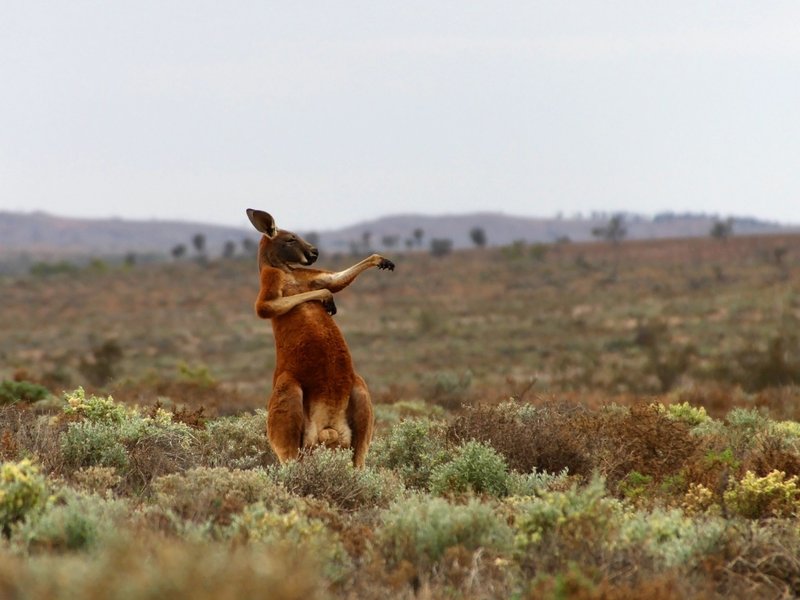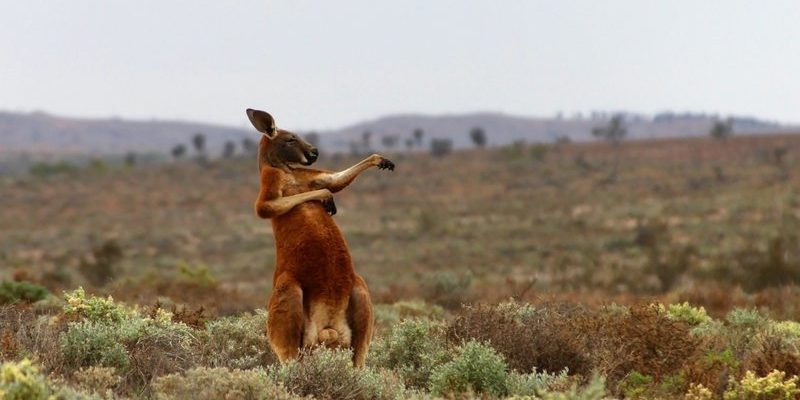
When you think about red kangaroos, you might picture their powerful hind legs or their long tails. But it’s their extraordinary survival skills that truly capture the imagination. Just like a well-designed Swiss Army knife, every feature of a red kangaroo serves a purpose in the wild. From their remarkable ability to conserve water to their unique social structures, these animals are adapted to face the challenges of their environment head-on.
So, how do red kangaroos manage to flourish where many others wouldn’t stand a chance? Let’s take a closer look at their amazing adaptations.
1. The Water-Saving Superheroes
Water is life, especially in the harsh Australian Outback. Red kangaroos have developed some impressive strategies to limit their water loss. Here’s the thing: they often get most of the moisture they need from the food they eat. Their diet mainly consists of grasses and leaves, which contain vital water content.
Additionally, red kangaroos have a unique ability to regulate their body temperature. They don’t sweat like humans do; instead, they can tolerate higher internal temperatures, which allows them to conserve water. By staying cool through behaviors like resting in the shade during the hottest parts of the day and being active during cooler evenings, they maximize their survival chances.
You might be wondering how they truly manage to thrive in such a dry climate. They reduce their activity levels during extreme heat, which minimizes water loss. It’s a smart way to ride out the hot Australian sun!
2. Mastering the Art of Locomotion
Red kangaroos are not just great at conserving water; they’re also masters of movement. Have you ever seen a kangaroo hop? It’s a sight to behold! Their powerful hind legs enable them to travel great distances in search of food and water. In fact, they can cover up to 30 feet in a single leap.
This impressive locomotion serves more than one purpose. By hopping, they can move quickly across vast, barren landscapes while expending less energy than if they were to walk or run. This energy efficiency is a game-changer in survival, allowing them to forage effectively without exhausting themselves.
Interestingly, their long tails help them maintain balance while hopping at high speeds. It’s like having a built-in stabilizer! This adaptation ensures they can navigate challenging terrains, whether it’s rocky outcrops or sandy dunes.
3. Social Adaptations for Survival
Social behaviors in red kangaroos play a significant role in their survival. These animals often live in groups called mobs, which can consist of anywhere from a few to over a hundred individuals. You might think of it as a community party where everyone looks out for one another.
Living in a mob has several advantages. Firstly, it helps kangaroos avoid predators. When they’re together, there are more eyes on the lookout for danger. If a threat is perceived, the mob can quickly alert each other and make a coordinated escape.
Moreover, mob behavior allows kangaroos to share information about food and water sources. They communicate through a series of sounds and movements, helping each other find the necessities for survival. It’s a bit like having a built-in GPS system for resources!
4. The Role of Temperature Regulation
Temperature control is critical for red kangaroos. They have a few clever tricks up their sleeves to keep cool. As I mentioned earlier, they can tolerate higher body temperatures, but that’s just the tip of the iceberg.
One key strategy is their specialized blood vessels. These vessels help transfer heat away from their core to the surface of their skin, ensuring they don’t overheat during the scorching days. They also engage in behaviors like licking their forearms or resting in shady areas, allowing them to cool down effectively.
You might not think about it, but the kangaroo’s fur plays a role too. Their short, fine fur reflects solar radiation, which helps keep them cooler. Just think about wearing light-colored clothes on a sunny day—same idea!
5. Dietary Adaptations for a Harsh Environment
What do red kangaroos eat, and how does it help them survive? Their diet primarily consists of grass, but not just any grass. They prefer younger, leafier plants that have a higher water content. This selective grazing helps them maximize their hydration levels while still getting the nutrients they need.
Interestingly, red kangaroos also have specialized teeth that enable them to easily chew tough plant material. Their molars are designed to grind down fibrous grasses, ensuring they can extract as many nutrients as possible. A kangaroo’s digestive system is adapted to break down these tough plants efficiently, allowing them to thrive even in scarcity.
When food sources are limited, red kangaroos can also enter a state of temporary dormancy, slowing down their metabolism until conditions improve. This amazing ability gives them an extra edge in tough times.
6. Coping with Predators
In the wild, survival isn’t just about finding food and water; it’s also about avoiding being someone else’s meal. Red kangaroos have evolved a few clever tactics to cope with predators like dingoes and eagles.
One of their primary defense mechanisms is their speed. When threatened, red kangaroos can sprint away at impressive speeds, reaching up to 35 miles per hour. This rapid escape ability often helps them outrun potential threats.
Additionally, their keen eyesight and hearing allow them to detect danger from a distance. With their head held high and eyes surveying the land, they can spot a predator lurking before it gets too close. It’s all about staying one step ahead!
7. Resilience in a Changing Environment
As climate conditions continue to evolve, red kangaroos show remarkable adaptability. They’ve been able to survive droughts and habitat changes better than many other species, thanks to their resilience.
During extreme dry spells, these animals can migrate to more favorable areas where food and water are available. This flexibility in their habitat choices allows them to cope with fluctuations in their environment.
You might be curious about how they handle different seasons. During wet periods, their populations can expand significantly since resources are plentiful. On the flip side, during droughts, they adapt by becoming more mobile and socially active, searching for better conditions. It’s truly impressive how they navigate their world!
8. Conservation and Future Challenges
Despite their adaptations, red kangaroos face new challenges from habitat loss and climate change. Urban expansion and agriculture are encroaching on their natural territories, forcing them into smaller, isolated patches.
Conservation efforts are crucial for ensuring the future of red kangaroos. Protected areas and wildlife corridors can help maintain their habitats, allowing them to roam freely and find the resources they need.
Understanding their remarkable adaptations not only highlights their survival but also underscores the importance of protecting these unique creatures and their ecosystems. By learning more about red kangaroos, we can appreciate the delicate balance of nature and work toward ensuring their continued survival.
In conclusion, red kangaroos are a testament to nature’s brilliance. Their ability to withstand harsh environments through their remarkable adaptations is a reminder of the resilience and ingenuity of life. Whether it’s through efficient water conservation, social behaviors, or temperature regulation, these stunning animals demonstrate how survival is a multifaceted challenge that requires teamwork and clever strategies. Let’s continue to cherish and protect these incredible creatures for future generations!

